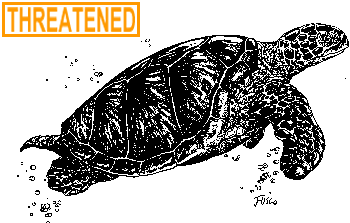Atlantic Green Sea Turtle
Chelonia mydas

Habitat: Shallow ocean waters inside reefs and in bays and inlets.
Weight: 220-441 pounds. Adults as large as 600 pounds have been documented.
Length: 35-48 inches.
Life Expectancy: Actual documentation of age is rare. Lifespan is estimated to be 50 years or more.
Food: Almost exclusively seaweed (turtlegrass) and green algae, and occasionally mollusks, crustaceans and jellyfish.
Status: Federally and state threatened.
Identification: Adult Atlantic green sea turtles have an oval-shaped, smooth carapace (top shell) without keels (ridged scales). There are 4 pairs of lateral scutes (plates) on the carapace and 4 inframarginal scutes (large scutes that connect the top and bottom shells) without pores on the plastron (bottom shell). The shell color varies widely from light to dark brown, olive green or bluish black, with brown mottling. The front and back flippers have one claw. There is no marked size difference between the males and females, but the males have a long, thick tail.
Range: The green turtle occurs along the North American coast from Massachusetts to Mexico and from British Columbia to California. Major nesting grounds are in Mexico, Costa Rica, Guyana, Suriname and Ares Island off Dominica, in the West Indies. In the United States, small nesting populations occur on the eastern coast of Florida.
Reproduction: After migrating together to the nesting area, male and female green turtles mate offshore. The females dig their nests at night on steeply sloped beaches. As many as 7 clutches can be laid in a season. The clutch size ranges from 75 to 200 eggs, and incubation takes 48 to 70 days, depending on beach and water conditions. Adults reach sexual maturity in 4 to 6 years in tropical waters and 5 to 13 years in temperate waters. Females may nest at 2, 3 or 4-year intervals.
Reason for Decline: While nesting, green turtles have been overexploited for turtle products and food (their cartilage was processed to make turtle soup). As a result, many nesting populations have been extirpated. In areas where populations have declined, excessive predation on eggs and hatchlings has further reduced their numbers. Shoreline development and beach use have limited the amount of undisturbed nesting beaches available for these turtles.
Boat propellers, which often inflict serious wounds on sea turtles, have been responsible for many turtle deaths. Commercial fishing and shrimping activities often cause turtles to drown or become mutilated or entangled in nets. Fortunately, federal regulations now require all shrimp trawlers in the Gulf of Mexico and the Atlantic Ocean to use turtle excluder devices (TEDs) year-round.
Discarded plastic bags and wrappers, helium balloons and monofilament fishing line that end up in the ocean can also be deadly to sea turtles, as well as to other marine life. Balloons and plastic bags, when floating in water, resemble jellyfish, which are occasionally eaten by the Atlantic green turtle. When turtles mistakenly eat these items or fishing line, their digestive system becomes blocked and they eventually die.
History in Connecticut: An Atlantic green turtle has never been found on the Connecticut shoreline to date. However, the species may occasionally migrate through Connecticut waters during the warmer months.
Interesting Facts: It has been estimated that green turtles migrate with precise navigation up to 1,400 miles between nesting beaches and feeding areas. They seem to make use of a sun/compass orientation similar to that of bees.
The herbivorous green turtle mainly feeds on turtlegrass that grows in the shallow waters of the tropics.
Protective Legislation: Federal - Endangered Species Act of 1973, CITES (Convention on International Trade in Endangered Species) Appendix I. State - Connecticut General Statutes Sec. 26-311.
What You Can Do: You can help sea turtles by not purchasing illegal turtle products, such as turtle leather and tortoise-shell items, and by properly disposing of or recycling plastic bags, fishing line and balloons. In an effort to help curb the problem of balloons in Long Island Sound, Connecticut has passed legislation limiting helium balloon releases to no more than 9 in a 24-hour period. With the help of a little wind, even balloons released in Connecticut's inland areas can end up in the Sound.
Many sea turtles are tagged for research with metal or plastic markers. Tags are usually on the inside edge of the front flippers; sometimes the rear flippers or the shell may be tagged. If you observe a tagged turtle, do not remove any tags unless the turtle is dead. Tag numbers should be reported to the address on the tag or to the Wildlife Division's Wildlife Diversity Program at deep.wildlife@ct.gov or 860-424-3011.

The production of this Endangered and Threatened Species Fact Sheet
Series is made possible by donations to the Endangered Species-Wildlife Income Tax
Checkoff Fund.
(rev. 12/99)

